Travel Log, Recent Entries
MAINLAND MEXICO, PART II
The Steamy Pacific Coast
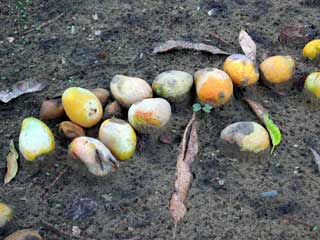
There's no other smell like mangoes
rotting under the tree. Pungent yet slightly delicious, catch a whiff and you know you are in the tropics.

Freshly exhilarated by our trek to the volcano, the next day we drove 300 miles from the indigenous mountain village of Angahuan to the seaside resort town of Zihuatanejo, pop. 40,000, a long day's drive away and worlds apart. We found a hotel right on the beach with a few parking places for rvs, dove into the warm water to escape the oppressively steamy heat, had a nice dinner in their open air restaurant, Ziggy sleeping at our feet. The name of the place is "El Mangler", not what you think; the name means mangrove. The two guys running it were good to us, sharing their wifi code and excellent signal so we could catch up with friends and family. We considered the yoga class offered in the morning, but we chose the beach instead, which made Ziggy happy.
Our night(mare) in Alcapulco
On to Acapulco, where Kathleen has many good memories of a visit as a teenager with her family. We foolishly passed up a nice campground on the outskirts to try for one Rus thought might be better, right in town, not having any idea that Acapulco is a city of 750,000 plus tourists, with traffic to match. 2-3 hours later, in the dark, with frayed nerves, we arrived, having been through the most hair-raising traffic conditions so far on this trip. With no visible street signs to guide us through town, little cars zipping chaotically across lanes, if you can call them lanes, horns blaring, narrow streets that shrank or ended abruptly at a cliff's edge, and dozens of balloon-festooned, horse-drawn carriages in search of tourists, it was bumper to bumper chaos, and we were totally lost the whole time. Once we were stopped by a cop and barely escaped another mordida. Rus did some fast talking and we got away clean with with directions we couldn't even use because we were too big to turn around. As the last light faded over the sea, we degenerated into yelling at each other for what we did wrong, which of course, was no help at all and only made things worse, until we finally came to our senses and hired a taxi to guide us to a campground on the other side of town. It was the best 5o pesos we ever spent! Near our destination, he misled us down a tree-shrouded lane where we tangled up in some low-hanging electrical lines and had to back out, Rus on the roof with rubber gloves, clearing the lines from the air conditioner and solar panels, Kathleen backing up SLOWLY on the dark pot-holed lane, worrying about Rus above. Not much fun, that. At least they turned out to be phone lines, not power.
 But we did find Diamante, a nice campground where we were given a concrete slab with a huge awning over us, a valuable asset as it rained torrents the three nights we were there. In season, this campground is filled with French Canadians; but we were the only ones there except the caretakers. Increasingly, this is what we find as we head further south, this is the rainy season, and snowbirds are all at home. We explored the nearby beaches on foot, did some shopping on our "moto", and took a taxi into town for a walk along Acapulco's famous malecon and had dinner in a Spanish restaurant. The panoramic views from the hilltops surrounding Acapulco are stunning, especially at sunset, and the city certainly deserves its reputation as a world-class resort, but 750,000 people is 3/4 of a million, and that's a lot of people in one place, at least for us. We never got to see the cliff divers, it was too difficult for us to maneuver in this town. Boy, were we grateful not to have to drive through Acapulco again on our way out. But we did find Diamante, a nice campground where we were given a concrete slab with a huge awning over us, a valuable asset as it rained torrents the three nights we were there. In season, this campground is filled with French Canadians; but we were the only ones there except the caretakers. Increasingly, this is what we find as we head further south, this is the rainy season, and snowbirds are all at home. We explored the nearby beaches on foot, did some shopping on our "moto", and took a taxi into town for a walk along Acapulco's famous malecon and had dinner in a Spanish restaurant. The panoramic views from the hilltops surrounding Acapulco are stunning, especially at sunset, and the city certainly deserves its reputation as a world-class resort, but 750,000 people is 3/4 of a million, and that's a lot of people in one place, at least for us. We never got to see the cliff divers, it was too difficult for us to maneuver in this town. Boy, were we grateful not to have to drive through Acapulco again on our way out.
Site of our Coco Cabana Accident. By the next day, someone had propped the lines we left hanging back up on the pole.
Puerto Escondido
 We got a very late start out of Alcapulco ( too much time in Costco) and we had a 246-mile drive ahead of us before dark. Hwy 200 is narrow and in poor condition, studded with topes (speed bumps) in every one of the numerous villages it passes through. Fortunately, we were listening to "The Power and the Glory" by Graham Green and the miles flew by. We had to break our 'Never Drive at Night' rule with nowhere to stop, and about one hour after dark, tired but safe, we pulled into the Paraiso Centro Turistico north of Puerto Escondido and found a level spot. In the morning we discovered it was aptly named, a little bit of Paradise, on the shores of a mangrove lined lagoon. We got a very late start out of Alcapulco ( too much time in Costco) and we had a 246-mile drive ahead of us before dark. Hwy 200 is narrow and in poor condition, studded with topes (speed bumps) in every one of the numerous villages it passes through. Fortunately, we were listening to "The Power and the Glory" by Graham Green and the miles flew by. We had to break our 'Never Drive at Night' rule with nowhere to stop, and about one hour after dark, tired but safe, we pulled into the Paraiso Centro Turistico north of Puerto Escondido and found a level spot. In the morning we discovered it was aptly named, a little bit of Paradise, on the shores of a mangrove lined lagoon.
The toilet had an interesting flush.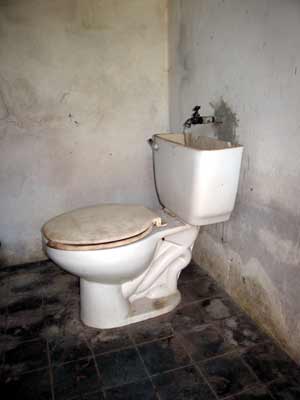
This little spot on the map called Puerto Escondido is a town of 40,000 and, to our surprise, is a world famous surfing destination. It has a fairly constant stream of young Americans and Europeans with the attendant hotels, restaurants and internet cafes. We parked right in town, got our mountains of laundry done while catching up on correspondence, found a really good, cheap organic restaurant where we ate every meal, and tried to go swimming but got a pounding by the waves instead. Did we also mention it was hot? It was really, really HOT, and we tried to cool off enough to go to sleep that night by laying wet dishtowels on our naked selves as we lay in bed with a fan on us. We'd fired up our generator to use the air conditioner, but shortly after it began to pump in delicious, cool air, it just died. In the morning it was still hot and getting hotter, so we took advantage of having a home on wheels, and rolled out of Puerto Escondido, headed for higher ground and cooler temperatures.

Yes, it's a piece of Styrofoam they surfed on for hours
OAXACA, teacher's strike takes over the Centro
 Having heard stories about Oaxaca for years, we headed East again into the mountains on the slow, curvy Hwy 131. The drive was around 250 km and took 8 hours, but that was fine with us, with good music and a lot to look at, and we were having fun! Having heard stories about Oaxaca for years, we headed East again into the mountains on the slow, curvy Hwy 131. The drive was around 250 km and took 8 hours, but that was fine with us, with good music and a lot to look at, and we were having fun!
Oaxaca (pop 300,000, elevation 5,100 ft) is the capitol of the state of Oaxaca, famous as an historic colonial city, artisan and fine arts center. We arrived in a rainstorm, traffic creeping through the flooded streets, and found our way to a faded campground that had sold off half of its property, leaving nowhere to turn around. We jockeyed into a space, just glad to settle in after our long drive. We were the only ones there except for a young Mexican hippie family that appeared to have been camped  there for months. In the morning we drove out to a very new-looking Ford dealership for what may be our last scheduled maintenance at a place that actually says "Ford" out front. We were looking for an oil and filter change, lube, brake inspection, etc., the usual stuff that takes an hour or less in the U.S. They were happy to do the service without an appointment, and said we could pick up our vehicle in the afternoon.....of the next day!! When Rus explained that this was also our home and we had no other arrangements, he got the time reduced to late that afternoon (we later learned that an inordinately long delay, whether at a government office or private business, is sometimes an opening to offer a bribe, or "mordida", to grease the wheels of progress, but it didn't work with us since we were so naive). On picking up our rig, we discovered they'd changed not just the oil filter, but also the fuel and air filters. Maybe they needed replacement, but we're willing to bet our old air filter is riding on another truck! Still, it always feels good to have fresh oil (we hope) sloshing around in our engine. there for months. In the morning we drove out to a very new-looking Ford dealership for what may be our last scheduled maintenance at a place that actually says "Ford" out front. We were looking for an oil and filter change, lube, brake inspection, etc., the usual stuff that takes an hour or less in the U.S. They were happy to do the service without an appointment, and said we could pick up our vehicle in the afternoon.....of the next day!! When Rus explained that this was also our home and we had no other arrangements, he got the time reduced to late that afternoon (we later learned that an inordinately long delay, whether at a government office or private business, is sometimes an opening to offer a bribe, or "mordida", to grease the wheels of progress, but it didn't work with us since we were so naive). On picking up our rig, we discovered they'd changed not just the oil filter, but also the fuel and air filters. Maybe they needed replacement, but we're willing to bet our old air filter is riding on another truck! Still, it always feels good to have fresh oil (we hope) sloshing around in our engine.
Above right: Ziggy guards our rig in the Oaxaca trailer park
Tents and tarps and teachers
 |
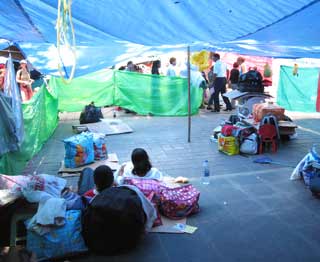 |
We never got to see the picturesque center of town with the artisan stalls that we'd heard so much about. We arrived in the midst of a teacher's strike and the downtown was chaos. We don't know what their complaints were, but these teachers were serious and they were taking a strong stand. They had taken over the entire center of town, creating a tent city by stringing ropes, tarps and tents throughout the streets so that traffic backed up to the city's edges in a sluggish, exhaust-ridden crawl. The newspaper said that teachers had ripped up a section of parking meters using hammers and chisels and deposited them at an important government building in protest. Bending low to pass through the narrow passages between tents we could see hundreds of respectable looking primary school teachers and their families sleeping, chatting or simply lounging around, their boxes and luggage scattered nearby holding what they needed until things returned to normal. Some sang songs of protest but in general it looked pretty mellow and we are sorry we never got to hear what came of it, impressed as we were with their spirit and willingness to put their jobs at risk.
 In Oaxaca we visited the Museo Regional, a very fine museum of Mexican history and anthropology, featuring the treasure from Tomb No. 7, a rare unlooted royal tomb from the nearby ancient Zacatecano city of Monte Alban. The Museo Regional is in the restored Santo Domingo church and convent (a monastery, actually), an impressive building to walk through even if it didn't house the museum. This huge complex, more than anything we've seen so far, impressed on us the wealth, reach, and power of the Catholic Church in the New World, and the vital role it played after the Conquest in the subjugation and exploitation of indigenous peoples and their resources. As Rus indelicately said, "There must have been just a shit-pile of monks here!" In Oaxaca we visited the Museo Regional, a very fine museum of Mexican history and anthropology, featuring the treasure from Tomb No. 7, a rare unlooted royal tomb from the nearby ancient Zacatecano city of Monte Alban. The Museo Regional is in the restored Santo Domingo church and convent (a monastery, actually), an impressive building to walk through even if it didn't house the museum. This huge complex, more than anything we've seen so far, impressed on us the wealth, reach, and power of the Catholic Church in the New World, and the vital role it played after the Conquest in the subjugation and exploitation of indigenous peoples and their resources. As Rus indelicately said, "There must have been just a shit-pile of monks here!"
And sure, we had to go to the famous Monte Alban, too. Even if these people had had bulldozers, which they didn't, not even wheels, this place would be impressive for the sheer amount of earth moved to create the huge plazas, ball courts, and temple platforms that make up the city center. Not to mention the rocks! If you stand on a high place in these ancient cities and sort of unfocus your eyes, you can almost see their former glory, all the buildings complete and in use, the surrounding farms and homes, the bustle of people at their work, the sounds of animals and of children playing. What remains today are the religious, ceremonial and political centers, their monuments to themselves and their gods, much like what would be left of our own civilization after hundreds of years or more of abandonment. The daily lives of these people, perhaps most interesting of all, is for the most part lost. Contrary to the record, they couldn't have spent all their time praying, honoring their kings, making things to bury in tombs, and mutilating the genitals of their captured enemies!!
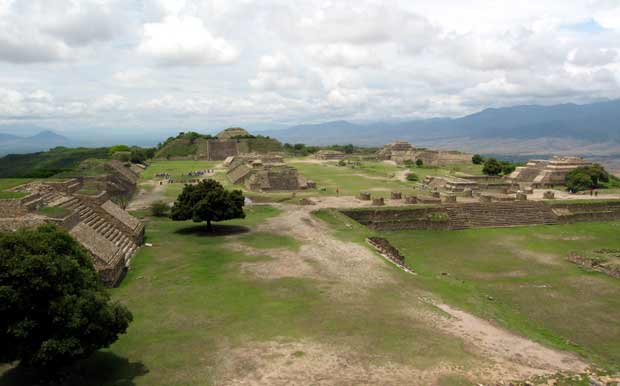
Monte Alban stands proudly on a magnificent hilltop overlooking the Valley of Oaxaca. To build it ancient Zapotec workers flattened the entire mountaintop. (2,460 by 820 feet)
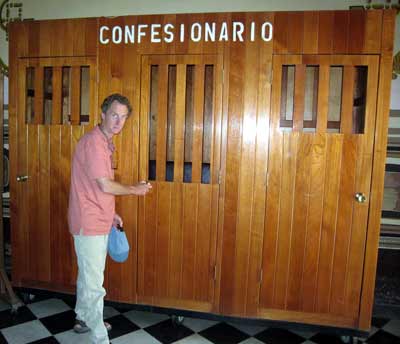
Having had our fill of tourist attractions, and wondering a little why everyone is so nuts about Oaxaca, compared to towns we ourselves are nuts about, like Zacatecas and Patzcuaro, and others to follow, we took the road south through a pueblo called Matatlan, which claims to be the Mescal capital of the world. We poked our noses into a small (they're all small) factory and learned how the stuff is made from agave, which is grown on all the hills for miles around. See the sidebar for details.
< It's about time, Rus!
CHIAPAS
On the way to San Cristobal de las Casas, in the state of Chiapas, the countryside displayed a face of Mexico we'd never seen. The first thing we noticed was that it became very clean. Less garbage, less air pollution, and incredible natural beauty. The land is lush, deep green, steep and jagged, with forests of pine, maples and many other trees we don't know the names of. Steep plots of land had been cleared and planted in corn and flowers, tree stumps remaining. And water was everywhere, rivers, streams, lakes, and soft mists brushing the the ridge tops. It was rainy season, very wet and very green in this special place on earth called Chiapas.
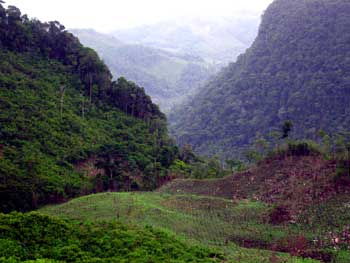 As we climbed higher, the air became clearer and cooler, the mountains more beautiful, dotted with tiny villages clinging to steep hillsides, then suddenly opening into graceful valleys, one after the other, holding grasslands and farmlands and indigenous villages, every one with a church, usually white, standing tall in a place of importance. As we wove through their settlements people stared at us in wonder, and we at them. Men carried hoes and machetes, and heavy loads on their backs. Women wore their colorful traditional dress. Each village had unique color combinations and a distinct style, always woven by hand, sometimes embroidered lavishly in brilliant designs, a constant visual delight. The children walked or worked beside their parents. We felt awfully big in our fancy white truck, but people smiled and waved, if we waved first. Finally, slipping through a pass onto a high plain ringed by mountains, we dropped into beautiful San Cristobal de las Casas, nudging out La Paz to soon become our favorite Mexican city. We found Hotel Bonampak, another of those hotels which offer parking spaces for campers in a large field behind their complex, and made ourselves at home, for 2 1/2 weeks the only ones there. As we climbed higher, the air became clearer and cooler, the mountains more beautiful, dotted with tiny villages clinging to steep hillsides, then suddenly opening into graceful valleys, one after the other, holding grasslands and farmlands and indigenous villages, every one with a church, usually white, standing tall in a place of importance. As we wove through their settlements people stared at us in wonder, and we at them. Men carried hoes and machetes, and heavy loads on their backs. Women wore their colorful traditional dress. Each village had unique color combinations and a distinct style, always woven by hand, sometimes embroidered lavishly in brilliant designs, a constant visual delight. The children walked or worked beside their parents. We felt awfully big in our fancy white truck, but people smiled and waved, if we waved first. Finally, slipping through a pass onto a high plain ringed by mountains, we dropped into beautiful San Cristobal de las Casas, nudging out La Paz to soon become our favorite Mexican city. We found Hotel Bonampak, another of those hotels which offer parking spaces for campers in a large field behind their complex, and made ourselves at home, for 2 1/2 weeks the only ones there.
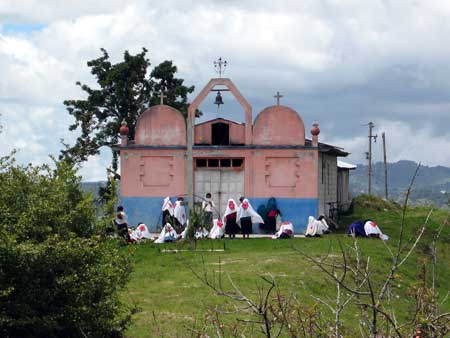
 Our Spanish lessons in San Miguel de Allende had been very helpful and we felt ready to take another round. After checking the schools in town, we signed up for individual private lessons at a wonderful school named El Puente (the bridge), an international cultural center and language school, also with internet services, a small cinema showing contemporary Mexican and international films and local documentaries, and an organic vegetarian restaurant and bakery, to boot. For two weeks El Puente was the focal point of our lives. We went online there, ate there, went to movies there, and studied there for three intense hours a day, plus homework. Our Spanish lessons in San Miguel de Allende had been very helpful and we felt ready to take another round. After checking the schools in town, we signed up for individual private lessons at a wonderful school named El Puente (the bridge), an international cultural center and language school, also with internet services, a small cinema showing contemporary Mexican and international films and local documentaries, and an organic vegetarian restaurant and bakery, to boot. For two weeks El Puente was the focal point of our lives. We went online there, ate there, went to movies there, and studied there for three intense hours a day, plus homework.
Our instructors, Eduardo and Yasmina, were patient and skilled, and we made long strides forward in our understanding of the Spanish language and Mexican Culture. Both of our teachers are young and curious, interested in culture and politics and use a variety of teaching methods. We even went on field trips. Rus sweated and worked hard at conjugations. Kathleen had long and fascinating discussions in Spanish about many aspects of Mexican (and North American) life, and, even if she didn't learn as much as Rus, she had more fun. We watched the Mexican Presidential debates and discussed them during class the next day, learning things we would never have known otherwise. We especially liked learning inside usages and details of the language and culture that we just couldn't know without a local sharing them.
Rus and Yasmina at El Puente, Kathleen's teacher Eduardo (also the school's administrator, with a law degree and 3 kids!) on a field trip
 |
 |
Learning Spanish is very important to us because we are as interested in the people as in the places we visit, and they are as interested in us, so it makes a huge difference to be able to take interactions beyond simple greetings and business transactions. What people are most interested in, besides "De donde vienen?" and " Como se llama su perro?" (Where are you from, and what's your dog's name) is whether we have kids and are any of them are married. When we tell them our son Jamie's getting married in September, a big smile comes over their faces. The family is the center of life here; it is in the U.S., too; we just don't realize it sometimes.
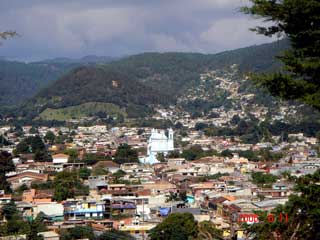 Several things stand out about San Cristobal. Probably the most obvious is the large population of indigenous people whose traditions, lifestyles, poverty and political struggles have made this region famous. On January 1, 1994, armed Zapatista rebels (for Emiliano Zapata, the legendary revolutionary leader) took over San Cristobal de las Casas and four other Chiapan municipalities, demanding free elections, the repeal of NAFTA, the end of the feudal system of land ownership, and the restoration of the "ejido" system, community-run property which could not be sold. The government, having just celebrated the signing of NAFTA the evening before, was outraged and embarrassed, and predictably came down with an iron fist. Lots of people were killed, but Several things stand out about San Cristobal. Probably the most obvious is the large population of indigenous people whose traditions, lifestyles, poverty and political struggles have made this region famous. On January 1, 1994, armed Zapatista rebels (for Emiliano Zapata, the legendary revolutionary leader) took over San Cristobal de las Casas and four other Chiapan municipalities, demanding free elections, the repeal of NAFTA, the end of the feudal system of land ownership, and the restoration of the "ejido" system, community-run property which could not be sold. The government, having just celebrated the signing of NAFTA the evening before, was outraged and embarrassed, and predictably came down with an iron fist. Lots of people were killed, but 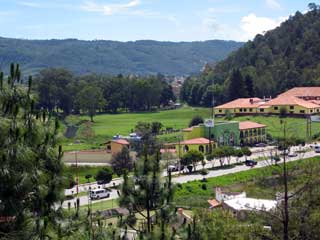 overnight the desperate plight of Mexico's indigenous population and the brutal response of the Mexican government became the focus of worldwide attention. Because of the international outpouring of support for the Zapatistas, the Salinas government was humiliated into negotiations with the rebels and making some concessions to their demands. As a footnote, NAFTA has been tough on Mexico, especially on corn farmers like the indigenous tribes, who can't compete with the flood of cheap Midwestern corn from the U.S. With NAFTA, the U.S. has also exported a lot of pollution to Mexico (along with a lot of jobs). We'd like to hear some good news about NAFTA; have we been talking to the wrong people? overnight the desperate plight of Mexico's indigenous population and the brutal response of the Mexican government became the focus of worldwide attention. Because of the international outpouring of support for the Zapatistas, the Salinas government was humiliated into negotiations with the rebels and making some concessions to their demands. As a footnote, NAFTA has been tough on Mexico, especially on corn farmers like the indigenous tribes, who can't compete with the flood of cheap Midwestern corn from the U.S. With NAFTA, the U.S. has also exported a lot of pollution to Mexico (along with a lot of jobs). We'd like to hear some good news about NAFTA; have we been talking to the wrong people?
Above left: San Cristobal de las Casas, Above: View from our hill above camp
 That's the short story of the Zapatista revolt. In fact, though, hardly anything has changed, and twelve years later, negotiations are at best ongoing, at worst stalled. Certain regions have declared themselves 'autonomous zones' (from Mexico) but they don't have the means to provide healthcare, roads or other infrastructure, so it is ambiguous and difficult for them when they need these things. The indigenous tribes are many, speak different languages, are disorganized, uneducated and unskilled, not to mention unsophisticated in self-government or in negotiating with the federal government. But they are getting a lot of help from outside, in the form of 100+ NGO's from all over the world, sending money and other support. There is a constant stream of politically active young people from That's the short story of the Zapatista revolt. In fact, though, hardly anything has changed, and twelve years later, negotiations are at best ongoing, at worst stalled. Certain regions have declared themselves 'autonomous zones' (from Mexico) but they don't have the means to provide healthcare, roads or other infrastructure, so it is ambiguous and difficult for them when they need these things. The indigenous tribes are many, speak different languages, are disorganized, uneducated and unskilled, not to mention unsophisticated in self-government or in negotiating with the federal government. But they are getting a lot of help from outside, in the form of 100+ NGO's from all over the world, sending money and other support. There is a constant stream of politically active young people from 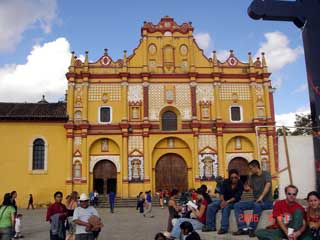 other parts of Mexico, the U.S., and especially from Europe into Chiapas to help with the movement, volunteering as teachers in the independent indigenous schools, training people in technical skills, providing health care and education, and serving as human rights observers, an especially important job as many of the hot spots are virtually surrounded by the army, with military checkpoints and patrols everywhere. San Cristobal seems to be the center for these help organizations, and an R&R center for many of the young volunteers. The influx of young foreigners has brought more diversity and sophistication to San Cristobal which now has internet cafes on every block, organic (even vegetarian) restaurants, and alternative cinemas. Judging from the number of little shops selling amber and jade jewelry, local crafts and textiles, San Cristobal must also have a vibrant tourist economy during the season, though we didn't see much of that. other parts of Mexico, the U.S., and especially from Europe into Chiapas to help with the movement, volunteering as teachers in the independent indigenous schools, training people in technical skills, providing health care and education, and serving as human rights observers, an especially important job as many of the hot spots are virtually surrounded by the army, with military checkpoints and patrols everywhere. San Cristobal seems to be the center for these help organizations, and an R&R center for many of the young volunteers. The influx of young foreigners has brought more diversity and sophistication to San Cristobal which now has internet cafes on every block, organic (even vegetarian) restaurants, and alternative cinemas. Judging from the number of little shops selling amber and jade jewelry, local crafts and textiles, San Cristobal must also have a vibrant tourist economy during the season, though we didn't see much of that.
 The indigenous peoples of Chiapas have been the victims of so much exploitation, manipulation, abandonment and well-intentioned meddling for so long, it's hard to see where it could end. A more recent and very visible example of this is the large number of "expulsados" who have moved from the rural communities into the larger towns. A flood of evangelical protestant missionaries from the United States arrived here in the 1970's and converted large numbers of indigenous people (actually, just the men; the women and children followed wherever the men went) to their particular brand of Christianity. Trouble was, these agricultural villages are communal and interdependent, and people had practiced their hybrid of traditional religion and Catholicism for many, many years. Religious freedom doesn't look the same to them as it does to us, and so they were ostracized, persecuted, and finally expelled from their villages. They can't even farm their own land, which has been appropriated by others in the village. Thousands of The indigenous peoples of Chiapas have been the victims of so much exploitation, manipulation, abandonment and well-intentioned meddling for so long, it's hard to see where it could end. A more recent and very visible example of this is the large number of "expulsados" who have moved from the rural communities into the larger towns. A flood of evangelical protestant missionaries from the United States arrived here in the 1970's and converted large numbers of indigenous people (actually, just the men; the women and children followed wherever the men went) to their particular brand of Christianity. Trouble was, these agricultural villages are communal and interdependent, and people had practiced their hybrid of traditional religion and Catholicism for many, many years. Religious freedom doesn't look the same to them as it does to us, and so they were ostracized, persecuted, and finally expelled from their villages. They can't even farm their own land, which has been appropriated by others in the village. Thousands of 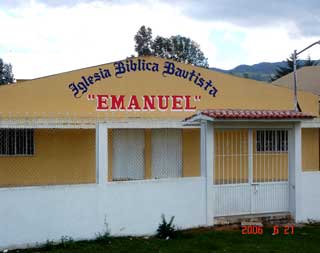 them live in the hills around San Cristobal in shacks, and make their livings begging and trying to sell crafts and trinkets in town. They are impoverished and desperate, without the support of their communities and without any social services in the towns they've been forced to move to. But, at least they're "saved". Rus has a low opinion of missionaries in general, and this has done nothing to improve it. We wonder how many of them stayed around long enough to see the results of their work. We continue to see these missionaries as we travel, and hope that more Latin American leaders will follow the lead of Venezuela's Hugo Chavez, who kicked them all out of the country. them live in the hills around San Cristobal in shacks, and make their livings begging and trying to sell crafts and trinkets in town. They are impoverished and desperate, without the support of their communities and without any social services in the towns they've been forced to move to. But, at least they're "saved". Rus has a low opinion of missionaries in general, and this has done nothing to improve it. We wonder how many of them stayed around long enough to see the results of their work. We continue to see these missionaries as we travel, and hope that more Latin American leaders will follow the lead of Venezuela's Hugo Chavez, who kicked them all out of the country.
A TALE OF TWO PUEBLOS
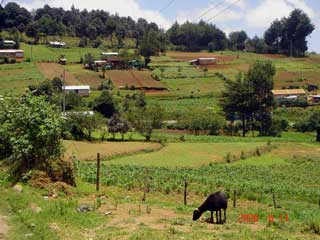 In the green mountains surrounding San Cristobal de las Casas are several small towns known for their specialty products and crafts. We took our "moto" out our first free Sunday, market day, to explore two of them, Zinacantan and San Juan Chamula. Winding through farms, pastureland and ridge tops offering panoramic views of this beautiful country, we dropped down into the village of Zinacantan. There was a wedding going on, with fireworks, traditional dancing, and two bands in the plaza in front of the church. The open-air market, where women were selling their traditional beautifully embroidered huipiles and other clothing, mostly to each other, was in another plaza to the side, everything displayed on the ground, hardly a chair or table in sight. We watched the wedding ceremony, a little self-conscious because of our height, white skin and American clothes. Some industrial-explosives-grade firecrackers went off nearby, and Rus cautiously approached the source, where four men were making dynamite-sized firecrackers out of sections of bamboo, tamping the powder down with wooden mallets. They each had identical kits, with calabasses for storing the black powder, and when new charges were finished and ready, they laid their mallets over them, handles all facing the same direction. In the green mountains surrounding San Cristobal de las Casas are several small towns known for their specialty products and crafts. We took our "moto" out our first free Sunday, market day, to explore two of them, Zinacantan and San Juan Chamula. Winding through farms, pastureland and ridge tops offering panoramic views of this beautiful country, we dropped down into the village of Zinacantan. There was a wedding going on, with fireworks, traditional dancing, and two bands in the plaza in front of the church. The open-air market, where women were selling their traditional beautifully embroidered huipiles and other clothing, mostly to each other, was in another plaza to the side, everything displayed on the ground, hardly a chair or table in sight. We watched the wedding ceremony, a little self-conscious because of our height, white skin and American clothes. Some industrial-explosives-grade firecrackers went off nearby, and Rus cautiously approached the source, where four men were making dynamite-sized firecrackers out of sections of bamboo, tamping the powder down with wooden mallets. They each had identical kits, with calabasses for storing the black powder, and when new charges were finished and ready, they laid their mallets over them, handles all facing the same direction.
 After a while we ambled over to the market, bought some tamales, and entertained ourselves watching a dog steal a bag of something from one of the sellers and skulk off behind a building to eat it. The only Spanish we heard was our own, buying the tamales. This was another world, and we were only observers in it. Zinacantan's farmland is owned and operated as a collective enterprise. The surrounding hillsides are dotted with greenhouses where cut flowers are grown, and this agriculture appears to be thriving. The people we saw looked healthy and alive, and at least prosperous enough to buy what they needed from each other in their small market. After a while we ambled over to the market, bought some tamales, and entertained ourselves watching a dog steal a bag of something from one of the sellers and skulk off behind a building to eat it. The only Spanish we heard was our own, buying the tamales. This was another world, and we were only observers in it. Zinacantan's farmland is owned and operated as a collective enterprise. The surrounding hillsides are dotted with greenhouses where cut flowers are grown, and this agriculture appears to be thriving. The people we saw looked healthy and alive, and at least prosperous enough to buy what they needed from each other in their small market.
By the way, Kathleen was drooling over the colors and designs in the women's clothing (their colors in Zinacantan are purple, green, teal and black with red and gold thrown in for accent), and even more so over the stunning ceremonial dress the men wore for their wedding dance. Some wore more layers than others or regal robes, all wore black hats with ribbons streaming down their backs worn over red bands of cloth wound around their heads. Their dress seemed to tell something about their position or role in the community. Most wore wooden shoes that made clomping sounds when they danced. It was really, really hard for Kathleen to keep her camera in her pocket in this visual paradise, but the indigenous people believe it is somehow bad to have their photos taken and if asked, most will refuse. That's why there are few examples of the colors and beauty we describe.
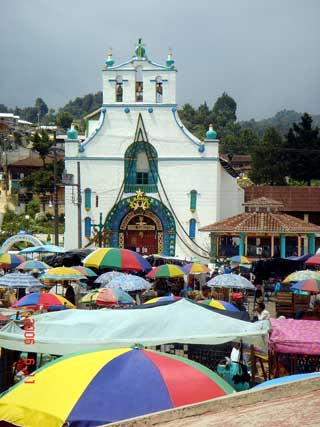 A few kilometers away, in a similar bowl surrounded by mountains lies the larger town of San Juan Chamula, with a large Sunday market and a permanent artisan market attracting locals as well as people like us from San Cristobal de las Casas. In the artisans market there was a sense of desperation about the place as venders begged us to look at their wares, reducing prices before we showed any interest at all. Many of them were selling identical factory-made Guatemalan textiles, which they represented as local hand woven work. In the food market as well, many of the venders and customers looked frayed at the edges, and so did their wares; the dried fish looked like it had been set out for sale every week for the last 2 years, and some of the fresh chicken didn't look much better. We found a man selling copal and bought a small quantity, then bought entry tickets to see the inside of the famous church, photo at left. A few kilometers away, in a similar bowl surrounded by mountains lies the larger town of San Juan Chamula, with a large Sunday market and a permanent artisan market attracting locals as well as people like us from San Cristobal de las Casas. In the artisans market there was a sense of desperation about the place as venders begged us to look at their wares, reducing prices before we showed any interest at all. Many of them were selling identical factory-made Guatemalan textiles, which they represented as local hand woven work. In the food market as well, many of the venders and customers looked frayed at the edges, and so did their wares; the dried fish looked like it had been set out for sale every week for the last 2 years, and some of the fresh chicken didn't look much better. We found a man selling copal and bought a small quantity, then bought entry tickets to see the inside of the famous church, photo at left.
Chamula's church offers outsiders an extremely rare opportunity to see the hybrid of Catholicism and traditional religion that is practiced by many of the Mayans. We were admonished at the entrance that photography inside was strictly prohibited. Stepping inside, we weren't ready for the scene that lay before us: the entire floor was blanketed in pine needles, except for patches cleared away by groups of worshipers to set out their candles. Not just a few candles, but rows and rows, thousands of them, stuck to the floor with melted wax, and many more on the tables set against the walls. The entire floor, though scraped, still felt tacky from candle wax of previous worshippers. The heat and light from so many candles, and the heavy smell of paraffin mixed with copal smoke was a powerful welcome. Also lining the walls were many glass-enclosed life-sized figures of the Saints, all suffering mightily and looking pretty unhappy about it, the wounds of the martyrs as gruesome as the artist could render them. 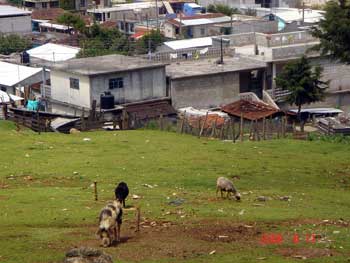 We found places to sit on the floor near some groups of worshipers seated in circles (there were no chairs or pews in this church) and, like the other visitors who paid their 30 pesos to come in, we watched and listened. Prominent in the ceremonies were Coca Cola and other soft drinks, the local cane alcohol called "posh", bunches of basil which are used for purification, lots of eggs, chickens in bags, either dead or soon to be, and much chanting. It appeared that people had come mostly to ask for help in curing sickness and other trouble, or purging evil spirits. The carbonated drinks were opened, symbolically waved over the candles as an offering, then drank down quickly to produce burping, allowing the sickness or malevolence to escape. The posh was what they originally used before discovering carbonation works better, but they still use it to keep with tradition, as the high is important, too (we noticed a drunk or two lying in a stupor on the floor). The raw eggs are waved over candles as they pray to absorb evil spirits and disease, and much attention is paid to their appearance as they're broken and inspected later at home, then buried or flushed down the toilet. The chickens we're not sure about, whether they're used as an offering, or, as Eduardo said, to draw out evil energies. The groups we watched were very casual about the whole thing, chatting among themselves in their circles between segments of ritual. But when they prayed, it was as if in trance and so powerful you got goose bumps listening. Children drank the posh just like the adults, though they made faces and added more coke to their cups. We hung out and watched for a long time, fascinated to witness a form of worship so different from anything we'd ever seen. Variations of this blend of Catholicism and Mayan religious traditions are practiced by indigenous people throughout this part of the world. We found places to sit on the floor near some groups of worshipers seated in circles (there were no chairs or pews in this church) and, like the other visitors who paid their 30 pesos to come in, we watched and listened. Prominent in the ceremonies were Coca Cola and other soft drinks, the local cane alcohol called "posh", bunches of basil which are used for purification, lots of eggs, chickens in bags, either dead or soon to be, and much chanting. It appeared that people had come mostly to ask for help in curing sickness and other trouble, or purging evil spirits. The carbonated drinks were opened, symbolically waved over the candles as an offering, then drank down quickly to produce burping, allowing the sickness or malevolence to escape. The posh was what they originally used before discovering carbonation works better, but they still use it to keep with tradition, as the high is important, too (we noticed a drunk or two lying in a stupor on the floor). The raw eggs are waved over candles as they pray to absorb evil spirits and disease, and much attention is paid to their appearance as they're broken and inspected later at home, then buried or flushed down the toilet. The chickens we're not sure about, whether they're used as an offering, or, as Eduardo said, to draw out evil energies. The groups we watched were very casual about the whole thing, chatting among themselves in their circles between segments of ritual. But when they prayed, it was as if in trance and so powerful you got goose bumps listening. Children drank the posh just like the adults, though they made faces and added more coke to their cups. We hung out and watched for a long time, fascinated to witness a form of worship so different from anything we'd ever seen. Variations of this blend of Catholicism and Mayan religious traditions are practiced by indigenous people throughout this part of the world.
 Back in San Cristobal we learned a little more about Chamula, that people are very poor there because most of the land is owned by a few very wealthy men, who run their farms on the feudal system. The town itself is controlled by four "jefes", one who has the Coca Cola distributorship, another the liquor distributorship, a third controls the tobacco business, and we can't remember the fourth; maybe that one owns the candle factory! Though you'd never know it by its shabby appearance, Chamula received more money from the PRI, Mexico's ruling party, than San Cristobal de las Casas, even though it's a much smaller town. The money went into the pockets of the ruling jefes as a reward for delivering the town's votes to the PRI in the last presidential election. We always like to dig a little to find out how things work in the places we visit, and sometimes, like in San Juan Chamula, it's not very pretty. In this region of Mexico, Chamula claims the highest number of "expulsados". In the closed loop of feudalism here, where religious practices also ensure a steady market for the sacrificial commodities controlled by the jefes, when a person steps outside the established religion they are no longer consumers for these goods and are expelled before the contamination spreads to others. Back in San Cristobal we learned a little more about Chamula, that people are very poor there because most of the land is owned by a few very wealthy men, who run their farms on the feudal system. The town itself is controlled by four "jefes", one who has the Coca Cola distributorship, another the liquor distributorship, a third controls the tobacco business, and we can't remember the fourth; maybe that one owns the candle factory! Though you'd never know it by its shabby appearance, Chamula received more money from the PRI, Mexico's ruling party, than San Cristobal de las Casas, even though it's a much smaller town. The money went into the pockets of the ruling jefes as a reward for delivering the town's votes to the PRI in the last presidential election. We always like to dig a little to find out how things work in the places we visit, and sometimes, like in San Juan Chamula, it's not very pretty. In this region of Mexico, Chamula claims the highest number of "expulsados". In the closed loop of feudalism here, where religious practices also ensure a steady market for the sacrificial commodities controlled by the jefes, when a person steps outside the established religion they are no longer consumers for these goods and are expelled before the contamination spreads to others.
Above and right:sign on the way to Palenque in the autonomous territories. Roughly translates as "Campesinos united for the resistance. Zapata said that greatness comes from returning the land to the campesinos. The land ought to belong to those who work it. Occupied territory."
MORE RUINS: PALENQUE
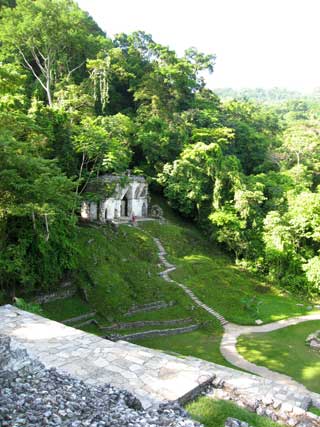 Kathleen is interested in the Mayans; their ruins, culture, religion, medicines, the whole works. Rus, on the other hand, thinks the Mayans were an ugly bunch with their cranial "alterations", warlike and cruel, and their neat calendar and the magnificent cities they built don't make up for it. Of course, neither of us really knows Jack about the ancient Mayan people themselves, just the ruling and priest classes, who as usual get to leave the permanent record. We left the coolness of the highlands for the steaming jungle to see Palenque, one of the most famous of the Mayan ruins. Having camped by ourselves for over two weeks in San Cristobal, we made a bet coming into the Mayabell campground at Palenque that it would be empty too. Kathleen won, but Rus still hasn't eaten the bug he promised to. In fact, there were lots of young folks there who'd arrived on buses, were camped in the palapas and showed no signs of being ready to leave, and even a couple of rv's, one with a German family, and another with actual North Americans from Atlanta. There was a pool, restaurant and bar, a gift store and live acoustic music. And to top it all off, electricity and hot showers! We were just amazed. Kathleen is interested in the Mayans; their ruins, culture, religion, medicines, the whole works. Rus, on the other hand, thinks the Mayans were an ugly bunch with their cranial "alterations", warlike and cruel, and their neat calendar and the magnificent cities they built don't make up for it. Of course, neither of us really knows Jack about the ancient Mayan people themselves, just the ruling and priest classes, who as usual get to leave the permanent record. We left the coolness of the highlands for the steaming jungle to see Palenque, one of the most famous of the Mayan ruins. Having camped by ourselves for over two weeks in San Cristobal, we made a bet coming into the Mayabell campground at Palenque that it would be empty too. Kathleen won, but Rus still hasn't eaten the bug he promised to. In fact, there were lots of young folks there who'd arrived on buses, were camped in the palapas and showed no signs of being ready to leave, and even a couple of rv's, one with a German family, and another with actual North Americans from Atlanta. There was a pool, restaurant and bar, a gift store and live acoustic music. And to top it all off, electricity and hot showers! We were just amazed.
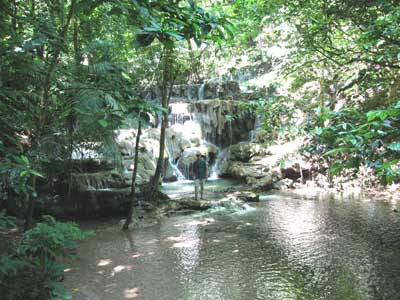 Early next morning we set off for the ruins, as people warned us Palenque gets uncomfortably hot by noon. But they were wrong; it was uncomfortably hot by 8:00 a.m.! Alfredo, one of the parking attendants, guided us into a shaded spot for Ziggy (though the ancient Mayans had dogs, they were no longer permitted on the premises), then we bought our tickets and entered the park-like grounds beyond the gate where the ruins lay. Well, we were the 11,203,676-7th visitors to have been awestruck by the sight before us, just as the first Spaniards who came to investigate reports of a lost city in the jungle in the 1700's, abandoned even then for many hundreds of years. The temple platforms are the first we've seen to have retained much of their original structures, though the restoration efforts have been careful to preserve the city as a ruin and Early next morning we set off for the ruins, as people warned us Palenque gets uncomfortably hot by noon. But they were wrong; it was uncomfortably hot by 8:00 a.m.! Alfredo, one of the parking attendants, guided us into a shaded spot for Ziggy (though the ancient Mayans had dogs, they were no longer permitted on the premises), then we bought our tickets and entered the park-like grounds beyond the gate where the ruins lay. Well, we were the 11,203,676-7th visitors to have been awestruck by the sight before us, just as the first Spaniards who came to investigate reports of a lost city in the jungle in the 1700's, abandoned even then for many hundreds of years. The temple platforms are the first we've seen to have retained much of their original structures, though the restoration efforts have been careful to preserve the city as a ruin and 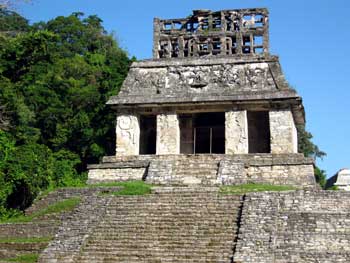 not a reconstruction. We followed a path down to a stream dropping into a series of inviting falls and pools, near the ruins of some domestic compounds, the "suburbs" of Palenque, now overgrown with jungle, trees rooted into the cracks between stones, Tarzan vines hanging everywhere, plants you've only seen in houses growing out in the open and in gigantic scale. We were spellbound, and the heat no longer mattered; in fact it just became part of the intensity of being in this magical place. For us, Palenque brought the ancient Mayans to life, as there's enough to see to visualize people living their lives, apart from their kings and religious ceremonies. Kathleen thinks that if you can only go to one ruin in the whole world it, it should be Palenque! not a reconstruction. We followed a path down to a stream dropping into a series of inviting falls and pools, near the ruins of some domestic compounds, the "suburbs" of Palenque, now overgrown with jungle, trees rooted into the cracks between stones, Tarzan vines hanging everywhere, plants you've only seen in houses growing out in the open and in gigantic scale. We were spellbound, and the heat no longer mattered; in fact it just became part of the intensity of being in this magical place. For us, Palenque brought the ancient Mayans to life, as there's enough to see to visualize people living their lives, apart from their kings and religious ceremonies. Kathleen thinks that if you can only go to one ruin in the whole world it, it should be Palenque!
Photo above: Temple of the Sun, below is Misol Ha Cascade
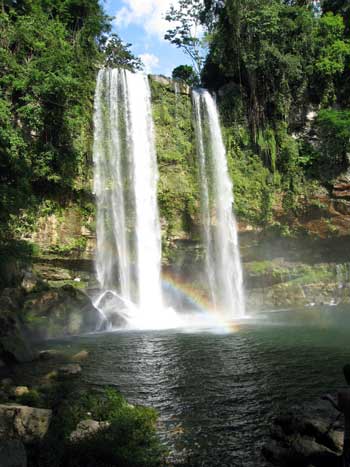 Eventually, though, the heat did drive us out, and we headed for the nearby Misol Ha waterfall to cool off. This fall spills over a sheer cliff, 200 feet or more, into a huge pool, then cascades into smaller isolated pools downstream, where we swam, threw sticks for Ziggy, and laughed as wild figs plopped into the water all around us from the trees above. We also had an adventure climbing up behind the falls, where pure underground springs flowed from openings in the limestone cliff. The largest of these exited from a cave, accessible by ropes, which we entered with our flashlights, struggling in the dark against the waist-deep current to the end where a river of water gushed from a large hole in the limestone, and stalactites (or is it stalagmites?) rippled in beautiful shapes from the ceiling, all this accompanied by the screaming Ziggy who was tied outside the danger zone. Without our waterproof flashlights we couldn't have seen this enchanting place; and we were thankful finally that at least some of the junk we brought on this trip has come in handy. After several hours at Misol Ha, we headed back to Maya Bell cool and refreshed, dined in our rig to a background of Spanish guitars and conga drums, and slept like the Mayan dead. Eventually, though, the heat did drive us out, and we headed for the nearby Misol Ha waterfall to cool off. This fall spills over a sheer cliff, 200 feet or more, into a huge pool, then cascades into smaller isolated pools downstream, where we swam, threw sticks for Ziggy, and laughed as wild figs plopped into the water all around us from the trees above. We also had an adventure climbing up behind the falls, where pure underground springs flowed from openings in the limestone cliff. The largest of these exited from a cave, accessible by ropes, which we entered with our flashlights, struggling in the dark against the waist-deep current to the end where a river of water gushed from a large hole in the limestone, and stalactites (or is it stalagmites?) rippled in beautiful shapes from the ceiling, all this accompanied by the screaming Ziggy who was tied outside the danger zone. Without our waterproof flashlights we couldn't have seen this enchanting place; and we were thankful finally that at least some of the junk we brought on this trip has come in handy. After several hours at Misol Ha, we headed back to Maya Bell cool and refreshed, dined in our rig to a background of Spanish guitars and conga drums, and slept like the Mayan dead.
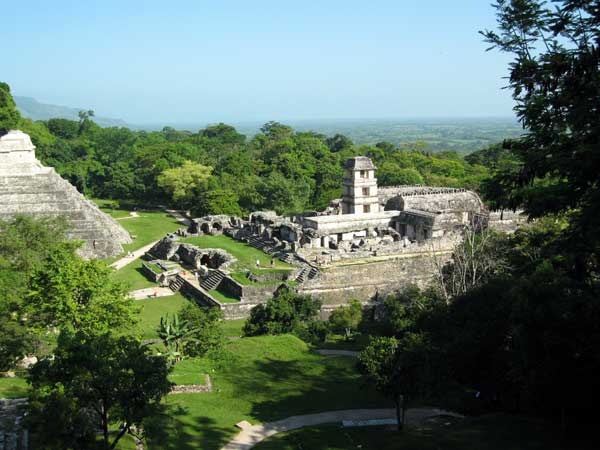
Temple of Inscriptions and the Palace
 Heading back to San Cristobal the next day, we fervently hoped our mail would be there so we wouldn't have to linger any longer before leaving for Guatemala. We couldn't believe we'd spent three and a half months in Mexico, and were planning to see all of Central and South America as well. We only have a year left, but looking at the map, it suddenly seems like a scant amount of time! Heading back to San Cristobal the next day, we fervently hoped our mail would be there so we wouldn't have to linger any longer before leaving for Guatemala. We couldn't believe we'd spent three and a half months in Mexico, and were planning to see all of Central and South America as well. We only have a year left, but looking at the map, it suddenly seems like a scant amount of time!
Of course, our mail hadn't arrived, so we decided to give it one more day before abandoning it altogether, home refinancing offers, oil change coupons, dolphin alerts and all, if it wasn't there tomorrow. Our mail is sent from a mail forwarding service called Escapees, in Texas. We call them when we want it sent somewhere, give them the address and hope to connect with it some time in the future. In Mexico, it's sent by general delivery, the "Lista de Correos", sometimes (and sometimes not) posted daily on the counter of the post office. If your name's on the list, your mail's there; if not, it's not (sometimes) .
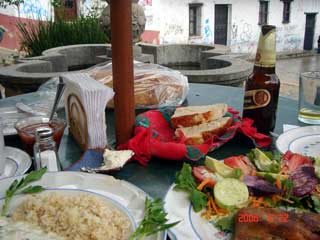 Next morning we weren't on the list either, so we took the unusual step of pursuing it further with the counter guy, who referred us to another guy in the bowels of the Correo. This guy, after confirming that our mail wasn't there, dug deep into a new stack of papers, found our name on one near the bottom, searched in a drawer, and pulled out a thick packet from Texas, joy of joys! It had been about three months since we'd received any mail, but except for the back issues of our favorite magazines it was hardly worth the trouble. Being of a generation that has lived most of its life before email, we still expect to find something important in the mail, and are constantly disappointed. We worry for the future of the U.S. Postal Service, but not enough to keep us awake nights. Photo: a last lunch in San Cristobal Next morning we weren't on the list either, so we took the unusual step of pursuing it further with the counter guy, who referred us to another guy in the bowels of the Correo. This guy, after confirming that our mail wasn't there, dug deep into a new stack of papers, found our name on one near the bottom, searched in a drawer, and pulled out a thick packet from Texas, joy of joys! It had been about three months since we'd received any mail, but except for the back issues of our favorite magazines it was hardly worth the trouble. Being of a generation that has lived most of its life before email, we still expect to find something important in the mail, and are constantly disappointed. We worry for the future of the U.S. Postal Service, but not enough to keep us awake nights. Photo: a last lunch in San Cristobal
We were finally ready to leave Mexico for Guatemala, excited but also sad to be leaving this beautiful country we'd grown to love so much, especially the lush green mountains and vibrant people of Chiapas, so rich in natural resources and beauty, so neglected and harassed by the government.

ADIOS, MEXICO! HOLA GUATEMALA!
to be continued......
|

